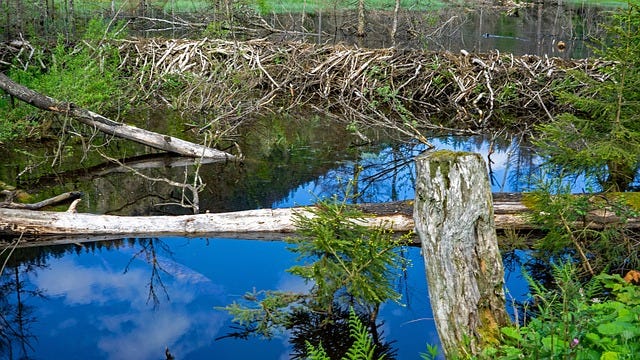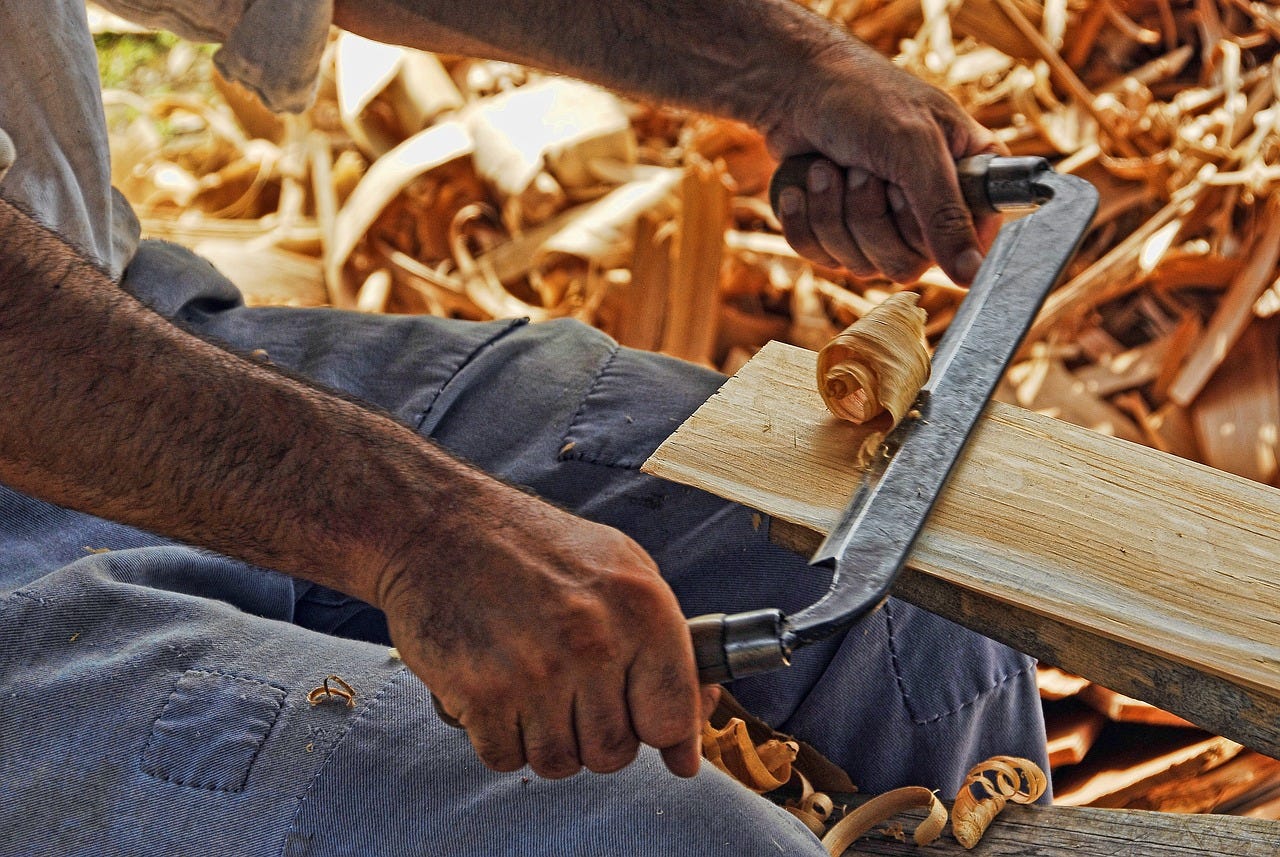What Can You Do With Thinned Pine?
“What can we do with all our thinned pine? It’s got no value!” We’ve heard this many times over the years from fellow mountain dwellers and land managers clearing trees and thinning stands ...
Photo by pb826 at Pixabay.com
What Can You Do With Thinned Pine?
by Pam Sherman
“What can we do with all our thinned pine? It’s got no value!” We’ve heard this many times over the years from fellow mountain dwellers and land managers clearing trees and thinning stands around homes and towns in an effort to reduce current high intensity wildfire intensity and return to historic low-intensity fire levels.
Curious, I began researching what people all over the globe have been doing with their thinned conifers, now and throughout history. There are enough ideas in the literature for lifetimes of commercial or DIY projects. To whet your appetite, consider the following (yes, some methods are even edible). For the full experience, click on the videos and links. When I explored the links with a classroom of upper elementary students at Gold Hill School, it took us three hours. But we were glued to the screen; no one wanted to stop.
Photo by Ujulala at Pixabay.com
Firewood
Throughout the world, the first use of thinned wood is fuel. If you are a mountain resident living near a publicly owned mitigation area, are you encouraged to pick up thinned wood for your winter woodstove? Neighbors often share with each other as well.
Photo by Jurgen Bierlein on Pixabay.com
Beaver dams are the prototype for popular human water-retention structures called beaver dam analogues
Water-Retention Structures
Can thinned wood help keep moisture on the land? Every splash of water is precious in arid and semi-arid regions.
Slash can be made into stream restoration and soil water retention structures such as beaver dam analogs, log splitters, log rundowns, drift and exclusion fences, log and fabric stepfalls at any scale. Rock is preferred in many cases; it lasts longer than wood and can withstand greater force, but it’s heavy and can be hard to get. It can be combined with slash to make low-tech structures.
For specific information on these structures and more, watch Bill Zeedyk’s presentation at the Quivira Conference; Zeedyk Structures are named after him. And watch his associate, restoration practitioner Craig Sponholtz’s presentation at a Permaculture Voices event. There’s much more online under the heading LTPBR, Long Term Process-Based Restoration.
Slash can also be processed into mulch and redistributed on the forest floor. If you are in a region like ours on the Colorado Front Range, check this Colorado Forest Restoration Institute guide to see if mulching is right for your project. It can also be left in slash piles, which pollinators need for sheltering, so the health of the forest actually depends on having as many piles as reasonable; just situate them so they are not a fire hazard.
Photo by Graham-H on Pixabay
Home-made Pellets, Chips, Mulch
If you have a pellet stove or want pellets for animal bedding, how can you can turn slash into wood pellets? WikiHow describes this step by step. With access to a wood mulcher/shredder, you can shred bark and wood into mulch for compost and other agricultural products, as well as for landscaping in wetter areas.
Paper-making in Myanmar courtesy OpenMyanmar on Wikimedia Commons
Home-made Paper
Pine, spruce, fir, hemlock, and a few other softwoods furnish 80 to 85 percent of all the wood used in the United States for papermaking--toilet paper, magazines, newspapers, books, cardboard, and many other paper products. Some sources say most of that is pine. Here are Wiki How’s instructions on making paper at home from pine.
photo by Analogicus from Pixabay.com Tree Resin
Turpentine, pitch, resins, rosins, glues, wood tar
Thinned pines also give us turpentine, resins, rosins, glues, wood tar. First, what’s the range of uses for these products? Next, how can you make them at home?
One company which makes tall oil rosin, rum rosin and wood rosin from pine resin, writes: “ Rosin is obtained by refining pine tree resin…The natural sticky property of rosin in rosin bags helps baseball players grip the ball better and violin players … [in] stabilizing the bow on the string[s]…
Pine resin has been integral to human life for… millennia and we continue to… use… rosin in a multitude of modern conveniences that include...electronic materials [such as computers and mobile phones]... car and house paint, adhesives used for bookbinding and packing tape, synthetic rubber in car tires.”
Pine pitch continues to be used for waterproofing, as a wood preservative, as glue, and as fuel for torches. This curious DIYer experimenting with pine pitch at home made some mistakes, but turned out some nice turpentine and beautiful resin. This recipe for pine glue and pitch looks promising. Here is a tutorial on making “survival” pine pitch.. This website discusses turpentine uses and how to make it at home.
Photo by Engin Akyurt on Pixabay.com
Traditional Uses for Thinned Pine
For millennia, people have also worked thinned pine and other species into split rail and other fencing, posts, gates, handrails, cabinets, barn and interior doors, windows, building interior and exterior siding, pole barns and sheds, raised garden beds, crates, boxes and pallets, indoor and outdoor log furniture including picnic tables, flooring, paneling, pallets and crates, siding and decking, tables, kitchen countertops, fireplace mantels, shelves, picnic tables, pergolas, baseboards, caskets, horse jumps, signs and many other hand-made items. Blue-stained Pine beetle-kill is often part of the aesthetic appeal. Access to a portable sawmill is useful for all the above and owning one can contribute to a small business income.
Photo by Hans on Pixabay Wood wool
Sawdust
Isn’t sawdust waste? This article on ways to use sawdust is not pine-specific, but easily adapted. Wood shavings are highly valued for landscaping in areas not subject to fires, animal and stall bedding and horse arenas. Wood wool (wood straw) is used for erosion control mats, packing material, crafts projects, cushioning, upholstery, stuffed toys, taxidermy mounts, swamp cooler evaporative cooling pads (and more). It can be quickly made using a home band saw. Here's how.
photo by antranias on Pixabay whimsical sculpture
Arts and Crafts
Ponderosa pine takes well to being carved, as this artist does with intricately shaped forest scenes on mantels; here is his 50- second you tube on shaping a Ponderosa pine. It can be made into bowls, jewelry, wreaths, and other arts and crafts including needle baskets. Blue-stained Pine beetle-kill is often part of the artistic appeal. USDA NRCS Ponderosa Pine Plant Guide notes that indigenous artists extracted a blue dye from Ponderosa roots and applied pine pitch inside whistles and flutes to create different tones.
“Pine Skins” are a creative use of Eastern White Pine bark; the technique is adapted from age-old traditions of bark cloth-making. If you try this with Ponderosa or other thinned trees, please let our readers know!
Ponderosa pine is a favorite in the art of bonsai (artfully miniaturizing trees), along with other species.
Yakisugi: wood preservation technique
This hails from a wet area (Japan) and is used in many more, but I couldn’t resist including it for beauty and usefulness on a small scale. Think “home woodstove” instead of using an outdoor fire. Sometimes called Shou Sugi Ban, yakisugi adds value to woodworking products. According to Nakamoto Forestry, “heat-treating wood is a standard universal human technology...it “makes wood stronger and will last longer... charred wood, resistant to rot, bugs, fire, water, requires no upkeep, [made with a] controlled light burn...People have been heat-treating wood since prehistoric times--hardening spear tips, walking sticks, digging sticks and other wooden hand tools, boat [hulls], exterior siding, whiskey and wine barrels, fence posts.” Here’s a demonstration of this traditional handcraft burning technique.
Photo by Ralph’s_Fotos on Pixabay.com
Biochar
At the other end of the fire intensity spectrum is biochar, “clearing the forest of wastewood, turning the product into almost pure carbon;” pines and other woods are incinerated to produce a compost-quality, charcoal-like substance. Questions on the process? Here are videos of a leading biochar manufacturer certified by the EPA. Forest managers everywhere are looking into this for possible post-fire forest recovery. It can be a powerhouse garden/farm soil amendment, when made right. Here is a paper on Biochar for Forest Restoration in the Western United States, food for thought.
Photo by Zellycat on Pixabay.com
Food and Drink
The blogspot at the Native American Museum notes that the Ponderosa pine seeds and inner bark were eaten and seeds were also crushed and used to thicken soup and make bread. The resin was sometimes chewed as gum to freshen breath.
This recipe for making bread with pine bark and phloem flour was inspired by the Sami people of Northern Sweden.
From Ireland comes this advice from 8 Ways to Eat Your Christmas Tree– “trees with soft pine needles are best.” From England has come an entire book, How to Eat Your Christmas Tree with innovative recipes for pines and more.
And on Youtube, a quick video on how to make spruce tree and pine pollen cookies.
In Bioconversion of Conifer Wood Chips Into Specialty Mushroom-producing Fungal Grown Suki Coan of the United States Forest Service discusses how [t]reated conifer wood chips can foster rapid mycelial growth of white-rot mushroom-producing basidiomycetes, which can be utilized for the production of gourmet and medicinal mushrooms.”
Most of us know about pine needle tea. But how many of us have heard of pine liquor or fancy pine wood dessert cake? The company Ethical Spirits in Japan is pioneering a project, "`Wood Spirits,’ to promote the commercialization and sale of `wooden liquor’ developed by the [Japan] National Forest Research Institute.” The wood includes a lot of “waste” pines. How do they do it? Here’s a hint – Lumber liquor: Scientists unveil alcohol that’s made from trees; we have to stay tuned for more specifics.
Earth Cuisine, a Japanese foodie company whose mission is to find new ingredients that are good for the earth and good for people, sells a specialty dessert, “Made from thinned wood…A whole new pound cake…Please enjoy.” (I used Google translate for both of these websites, recommended to me by Japanese food writers.) How do they do it? The closest I’ve come is this article with more information on how the Sami do it.
Photo by mrscaz on Pixabay.com
Medicine
The paper How to recover more value from small pine trees: Essential oils and resins
from the USDA Rocky Mountain Research Station in Arizona looks into “integrating recovery of essential oils by steam distillation into a program of forest thinning.” Articles and books abound on the medicinal benefits of pines and their essential oils; this one or this one are good places to start.
There are hundreds of practical ways to use the gift of thinned wood from around our homes or from a landscape-scale mitigation project. Let us know how you are doing it!
Based on my article of the same name originally published on Jan 22, 2022. Updated for the Mountain Resilience blog, Plant Resilience section March 17, 2024.














